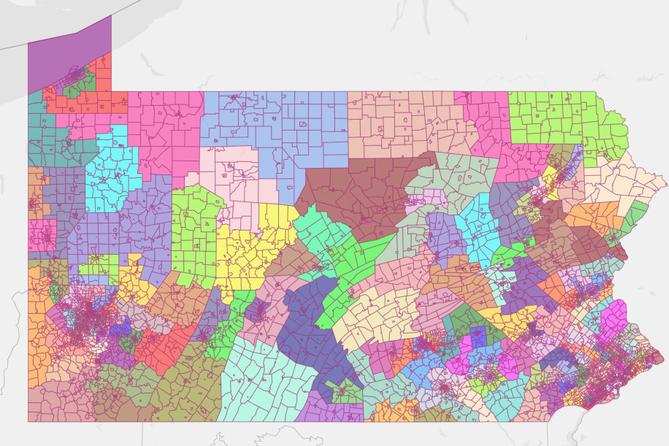This article is part of a yearlong reporting project focused on redistricting and gerrymandering in Pennsylvania. It is made possible by the support of Spotlight PA members and Votebeat, a project focused on election integrity and voting access.
HARRISBURG — A panel of Pennsylvania’s most powerful lawmakers released new proposed maps for the state’s House and Senate districts Thursday that could dramatically alter the balance of political power in Harrisburg for the decade to come — with the advantage swinging to the Democrats.
The maps were drafted and approved by the Legislative Reapportionment Commission, a five-person panel made up of the four top legislative leaders from both parties and a nonpartisan chairperson selected by the Pennsylvania Supreme Court.
You can view the House map here, the Senate map is available here, and to get involved in the process, you can submit comments on the proposed maps here.
The proposed maps could reshape the 50-member Senate and 203-member House, which are both controlled by Republicans, and will also determine how well growing communities of color across the state are represented in the General Assembly. The legislature wields significant influence, setting policy and budget priorities that affect everyone in the state.
The proposed House map drew the most attention because of its potential to shift control of the chamber to Democrats. Republicans currently hold a 113-90 advantage and have been in the majority since 2010, despite the fact that they are in the minority of registered voters in the state. That’s in part because Democrats are so heavily concentrated in certain areas.
Adam Podowitz-Thomas, a senior legal analyst for the nonpartisan Princeton Gerrymandering Project, said the new map creates about 102 districts that lean Democratic.
“We anticipate that the new map would give Democrats a real chance of taking the majority in the House of Representatives,” Podowitz-Thomas said. “There are seventeen districts we would consider competitive, meaning that the final outcome will very much come down to candidates and turnout.”
The Princeton project gave the House map a grade of ‘C’ overall and said it leaned Democratic in terms of overall fairness. The map was given an ‘F’ for competitiveness, meaning most districts clearly favor one party or another. The map scored better for compactness and minimizing county splits, receiving a “B.”
Democrats assert the House map would undo years of unfair Republican gerrymandering. Since 2015, Democratic Gov. Tom Wolf has routinely used his veto to block the Republican agenda, but that could change depending on the outcome of next year’s gubernatorial election. Wolf, who is term-limited, cannot run again, setting up a wide-open race that is sure to attract national attention.
“I’m proud of the preliminary product that we advanced today, as well as the thoughtful and bipartisan process we used to get here,” said Senate Majority Leader Jay Costa (D., Allegheny).
But a key Republican on the panel trashed the House map as a clear effort by Democrats to seize control. House Majority Leader Kerry Benninghoff (R., Centre) said Democrats sought to twist gerrymandering in their favor rather than end it.
“Drawing a map that is meant for no other reason than to cement a legislative majority for a certain party for our coming decade [does] not undo the wrongs that they seek to correct,” Benninghoff said. “They repeat them. They perpetuate them. They revel in them.”
“I see this map as extremely partisan gerrymandered.”
The House map creates 12 majority-minority districts, meaning a single community of color comprises the majority, which is the same as the current map. But it would also create 13 coalition districts, or those in which communities of color collectively comprise the majority. The current map has only six coalition districts.
Advocates for greater representation for communities of color — which are driving Pennsylvania’s population growth — said they would be reviewing the maps closely.
“We are particularly concerned with ensuring that Pennsylvania communities are protected and that all Pennsylvanians, but especially Black, Latinx, Asian, Pacific Islander, and other voters of color have an equal opportunity to elect a candidate of their choice,” said Khalif Ali, executive director of Common Cause Pennsylvania.
More than 40 counties in the west, central, and northern parts of the state saw declines in population during the past 10 years, while the southeast continued to grow. The share of residents who identify as white alone declined from nearly 82% to 75% from 2010 to 2020, as the Hispanic population grew and the number of Black residents remained roughly the same.
The House map passed by a 3-2 vote along partisan lines, with the two Democrats and the independent chairperson, Mark Nordenberg, voting in favor.
The proposed Senate map passed unanimously and received an overall “A” grade from the Princeton Gerrymandering Project, in part because it did not give either party a clear advantage. Republicans currently hold a 28-21 advantage over Democrats and one Independent and have controlled the upper chamber since 1994.
Both maps create new districts in urban areas that experienced population growth, such as Allentown, Philadelphia, and Montgomery County. Those seats were made by reducing the number of districts in more rural areas that experienced population decline — and which are dominated by Republicans.
For example, Senate President Pro Tempore Jake Corman’s (R., Centre) seat would be moved south to accommodate for the greater population growth in Cumberland County. Corman, who is running for governor, recently announced he would not seek reelection.
Nordenberg said in opening comments that the redrawing process was inherently partisan because it was in the hands of lawmakers with a vested interest in protecting their members and growing their power, as opposed to an independent citizens’ panel. But he stopped short of endorsing either path as preferable in the future.
Fair district advocates in the state have advocated for years for the redistricting process to be taken out of lawmakers’ hands, but that change would require those lawmakers consent, and historically both parties have been loath to cede any power.
Editor’s note: This story has been updated to clarify language around an assessment of the proposed House map’s compactness and county splits.
WHILE YOU’RE HERE… If you learned something from this story, pay it forward and become a member of Spotlight PA so someone else can in the future at spotlightpa.org/donate. Spotlight PA is funded by foundations and readers like you who are committed to accountability journalism that gets results.

